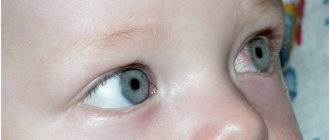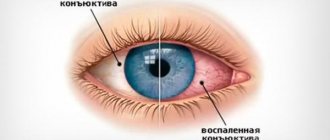Eye color is an interesting topic that has fascinated many researchers for centuries. Today, science is helping us learn in more detail about the nature of the origin and characteristics of changes in eye color in a child, and most importantly, how it is inherited. Many parents want to predict the eye color of their baby, but this is not so simple, because it depends on a number of different factors. In addition, the task is complicated by the fact that almost always newborn babies have blue eyes, which will eventually change anyway. Around the age of four, the eyes acquire their permanent color, be it blue, brown, green, gray, amber or dark brown. How then can you understand what color your child’s eyes will be? This will be discussed in this article.
What factors affect eye color?
The color of a child's eyes depends on many factors. Mainly the following points stand out:
- The amount of melanin. The color of the skin, hair and eyes in children depends on the content of melanin pigment in the body. It is melanin, in turn, that protects us from exposure to ultraviolet rays. The child’s eye color is completely stabilized when this pigment appears in sufficient quantities in the body. The higher the level of melanin in your baby's irises, the darker the shade of his eyes will be.
- Genetic inheritance. What color the child’s eyes will be depends on the parents’ genes. However, it should be borne in mind that great-grandparents also make a generous contribution to your child’s appearance. It turns out that the shades and colors of their eyes have a polygenic type of inheritance (several genes are responsible for one trait).
Taking into account the shade of the parents' eyes, scientists calculated the percentage of the possibility of inheriting a particular color and compiled the results into a single table. Finding such tables on any website will not be difficult. Naturally, the data obtained from them is not one hundred percent.
Why and how does a child’s eye color change?
There is a lot of debate on the topic of why a child's eye color changes. But modern science has not yet determined the cause of this phenomenon. A newborn child's eye structure is almost the same as that of an adult. This is a certain system that consists of many optic nerves that transmit information received from the environment directly to the brain. It is not yet possible to fully study such a complex system, but there are some changes in the color of a child’s eyes, from which one can learn something about his physical or emotional state, for example:
- when he wants to sleep, his eyes become cloudy;
- when the baby is hungry, the iris resembles a thundercloud (gray);
- when the baby cries - green;
- when the baby is absolutely healthy - sky blue.
As mentioned earlier, during the first 4 years of life, the child’s eye color changes and gradually becomes constant. Don't worry if it differs from your father's or mother's at the same time, because over time the color of the iris will still change.
Why are all children born blue-eyed?
The first question that arises among the relatives of a newborn is: who does the baby look like?
Blue-eyed baby (Photo: Fotolia.com)
Immediately after birth, mom begins to peer into the tiny face of the little man, dad tries to find his own features, looking at the baby through the window of the maternity hospital. However, do not forget that a newborn does not always look the same as on advertising brochures. The baby may have an irregularly shaped head, sometimes even with some deformities. This is fine. After some time, the swelling will subside and everything will return to normal. Of particular interest is traditionally the color of the baby's eyes - most often a child is born with blue eyes. Why is this happening? Does eye color change?
How does the organ of vision work in babies?
The structure of a newborn's eye is similar to that of an adult. This is a kind of camera - a system that includes optic nerves that conduct information directly to the brain, and specifically to those parts of the brain that perceive and analyze what is “photographed.” The eye consists of a “lens”—the cornea and lens—and “photographic film”—the sensitive shell of the retina.
However, despite the fact that a child’s eye is identical to an adult’s organ of vision, it is not yet capable of fully functioning. A newborn's visual acuity is reduced; he simply senses light, nothing more. But gradually, with development, the child’s visual acuity increases, reaching 50% of the adult norm by the age of one.
During the first week of life, doctors test the newborn's vision by the reaction of the pupils to light. In the second week of life, the baby can focus his gaze on a specific object for several seconds. Don't forget to visit an ophthalmologist when your baby is one month old! At two months, the baby's gaze becomes stable. By the age of six months, the baby is able to distinguish simple shapes, and by one year - drawings.
What does color depend on?
The color of the iris depends directly on the amount of melanin, a pigment found in the iris of the eye. Despite the fact that a baby is almost always born with bright or light blue eyes, the final eye color is formed by 2-3 years, when the melanin pigment appears. Therefore, the initially light eyes of children gradually become brown, green or gray. The darker the baby's eye color, the more melanin has accumulated in the iris. By the way, the amount of melanin is genetically determined. Research has shown that there are more brown-eyed people in the world than light-eyed people, and the reason for this is the genetic dominance of traits associated directly with a large amount of melanin. That is why if one of the baby’s parents has dark pelvises, and the other has light ones, then there is a high probability that their child will be brown-eyed. However, it also plays a role what eye color the grandparents on both sides had. Genetics is a serious science, everything is according to the laws of nature.
Can a brown-eyed child be born to blue-eyed parents?
Situations where brown-eyed children are born to blue-eyed parents are quite rare. Indeed, from the point of view of the laws of genetics, it is very difficult to explain such a phenomenon: where could a dominant gene appear in a child if it did not appear in the parents? And yet such cases do occur, and geneticists easily find an explanation for this.
The fact is that there are different genes - dominant (strong) and recessive (weak). The gene for brown eyes is dominant, while the gene for light blue eyes is weak. If a baby inherits a “brown-eyed” gene from one parent and a “blue-eyed” gene from the other, then most likely his eyes will be brown. But how can you find out which gene will be passed on to the child from each of the parents, if they have two of them? Indeed, behind the brown eyes of a mother or father, for example, there may be a recessive gene for light blue eyes.
The standard scheme for inheriting eye color in a child looks like this: for example, both parents are brown-eyed, but each of them has a weak blue-eyed gene. This means that such a couple has 3 out of 4 chances of having a child with brown eyeballs and only one chance with blue ones. If we take into account only this technique, then blue-eyed parents cannot have brown-eyed children. However, geneticists claim that, although in extremely rare cases, a brown-eyed child can still be born to blue-eyed parents. The explanation lies in the fact that a group of genes from each parent is responsible for such a trait, and not one gene, as was previously believed. Moreover, each time this series of genes is combined differently. So, owners of honey, hazel and brown eyes may well have blue-eyed children, but often brown-eyed ones still appear.
All blue-eyed people have a common ancestor and are relatives - scientists
If you have blue eyes, you're most likely distantly related to Frank Sinatra, Leonardo DiCaprio, Cameron Diaz and the late King Richard III, scientists say. It turns out that all blue-eyed people have a common ancestor from the Mesolithic era, who had an unusual genetic mutation, the British newspaper The Independent reported, citing an article published in the journal Nature. He lived about 400 generations from us, and thus all blue-eyed people are 400 cousins, notes the Israelinfo website.
A complete decoding of the genome of a man who lived about 7-10 thousand years ago in the northwestern part of the Iberian Peninsula (the territory of modern Spain), carried out by scientists, led to sensational results.
Researchers have discovered that this Mesolithic hunter-gatherer is the oldest known owner of blue eyes to date. The reason for this was a mutation in the HERC2 gene on chromosome 15.
Initially, the species homo sapiens had brown eyes, but their color, as well as the intensity of skin pigmentation, began to change significantly as the ancestors of modern humans began to spread across the planet from the territory of modern Africa. This was determined mainly by a mutation in the OCA2 gene, which reduced the production of melanin in the body, so scientists previously believed that one of the variations of this gene was responsible for blue eyes. However, it was never possible to find her. It turned out that the neighboring HERC2 gene simply deactivates OCA2.
“Blue eyes in modern humans are associated with the same mutation in a gene called HERC2. If you have this mutation in both copies of your chromosomes [one from your mother and one from your father], you are 100% likely to have blue eyes. This was the case with this man, who is the oldest known owner of this mutation to date,” said Carles Lalueza-Fox from the Institute of Evolutionary Biology in Barcelona.
The remains were found in the La Braña Arintero cave (province of Leon, northwestern Spain) back in 2006. In 2012, the decoding of itochondrial DNA, which was isolated from a skeletal tooth, was completed. Then the researchers were able to isolate nuclear DNA and completely decipher the genome of a person who lived in the Mesolithic era.
What was unexpected for scientists was that the man had dark hair and was dark-skinned. His genes go back to his ancestors on the African continent.
“A huge surprise for us was that the man had an African version of the genes that are responsible for the skin pigmentation of modern Europeans. That means he had dark skin,” Carles Lalueza-Fox said.
According to scientists, all the ancestors of modern Europeans had dark skin, but then it began to turn white due to a change in diet, when instead of eating what they got from hunting and fishing, people switched to food that was grown in the fields. Such food did not provide the body with the necessary amount of vitamin D. To replenish it, the process of evolution provided homo sapiens with white skin, which allows the production of vitamin D under the influence of sunlight, the Komsomolskaya Pravda website recalls.
By examining the genetic material of modern Europeans, scientists have found that the Iberian hunter-gatherer is closest to the Scandinavians.
“The presence of genetic characteristics that are responsible for blue eyes in modern Europeans surprised us even more. These features correspond to the phenotype (the totality of all the characteristics of an individual, formed in the process of interaction of its genotype and the external environment), which in other cases belongs exclusively to northern Europeans,” noted Carles Lalueza-Fox.
Northern Europe, along with the Baltic states, is the world leader in the number of people with blue and blue eyes. In Estonia, almost 99% of the population has this color. In addition to Europe, blue and blue eyes are found in the population of North America and Australia, as well as in the Near and Middle East, including Iran, Afghanistan and Lebanon, and among Ashkenazi Jews.
The previous ancestor of blue-eyed people was found in 2008 in the Black Sea region, but its age was “only” 10 thousand years.
The HERC2 modification that gives people blue eyes is recessive, so the number of blue-eyed people on the planet is declining. In order for a child to have eyes of this color, both parents must have the HERC2 mutation - but even then, the baby will only be born blue-eyed with a 75% chance. The decline in such people can be seen in individual countries. Large-scale studies of this kind were carried out, for example, in the USA. Among the white American population born in 1899-1905, the proportion of people with blue eyes was 54.7%, in 1936-1951 - 33.8%, and now this figure has dropped to 22.3%. The skin color of those who will live on earth after us will also change. Researchers believe that people of all skin colors will mix on the planet, and all our descendants will be equally dark-skinned.
Not long ago, on the anniversary of the publication of Darwin’s theory, the 360 TV channel tried to understand popular myths and misconceptions about evolution. Read more>>











